» posted on Monday, September 24th, 2012 by Linda Lou Burton
Sentinels in Bronze
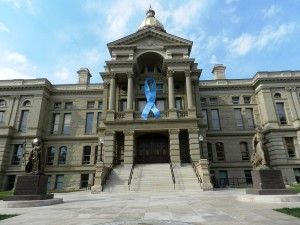 Linda Burton posting from Cheyenne, Wyoming – Esther Hobart Morris and Shoshone Chief Washakie have several things in common. Bronze statues of the two flank the entry to the Wyoming State Capitol, that’s the first thing; and replicas of those statues represent the state in National Statuary Hall in Washington, DC. The stories told about them have elevated them to the status of legends; larger-than-life icons that changed the world in a flash. But these two were simply orphans who were dealt some hard knocks, and who faced them in the best way they could. I find no record that their paths ever crossed, but they shared the same space in time, living through most of the turbulent 1800’s, and they shared minority status as the law and the social climate related to them. A woman, and an American Indian; exactly what did these two people face, and how did they respond?
Linda Burton posting from Cheyenne, Wyoming – Esther Hobart Morris and Shoshone Chief Washakie have several things in common. Bronze statues of the two flank the entry to the Wyoming State Capitol, that’s the first thing; and replicas of those statues represent the state in National Statuary Hall in Washington, DC. The stories told about them have elevated them to the status of legends; larger-than-life icons that changed the world in a flash. But these two were simply orphans who were dealt some hard knocks, and who faced them in the best way they could. I find no record that their paths ever crossed, but they shared the same space in time, living through most of the turbulent 1800’s, and they shared minority status as the law and the social climate related to them. A woman, and an American Indian; exactly what did these two people face, and how did they respond?
Esther Hobart Morris is labeled a “businesswoman,” “wife and mother,” and “Mother of Woman Suffrage” and was the first woman appointed to judicial office in the modern world. Chief Washakie is labeled “fierce warrior,” “skilled diplomat,” and “great leader” and is the only known Native American to be given a full U S military funeral.
Esther Hobart Morris (1814-1902)
 Esther was born in Tioga County, New York in 1814 and orphaned at an early age. She apprenticed to a seamstress, and eventually ran a successful millinery business making hats and buying and selling goods for women. She was 27 when she married Artemus Slack, a civil engineer. They had one son before Artemus died; as a widow with an infant Esther traveled to Illinois where her husband had owned property. The law of the times barred her from owning or inheriting that property, however. She quickly married again, this time to John Morris, a merchant. She and John had twin sons in 1851 when Esther was 37; life continued in Illinois.
Esther was born in Tioga County, New York in 1814 and orphaned at an early age. She apprenticed to a seamstress, and eventually ran a successful millinery business making hats and buying and selling goods for women. She was 27 when she married Artemus Slack, a civil engineer. They had one son before Artemus died; as a widow with an infant Esther traveled to Illinois where her husband had owned property. The law of the times barred her from owning or inheriting that property, however. She quickly married again, this time to John Morris, a merchant. She and John had twin sons in 1851 when Esther was 37; life continued in Illinois.
It was 1868 when husband John and Esther’s oldest son Archy, age 26, decided to head for gold rush country in Wyoming Territory. They opened a saloon in South Pass City; the next year Esther and the twins Robert and Edward joined them. Esther was 55 when she stepped off the stage and was escorted to her new home; a log cabin with a sod roof in a barren gulch at the mouth of a canyon; elevation 7,500 feet, near the Continental Divide. Quite a change from the fertile Illinois environment she had left. Was it a fluke, or was it fate, that brought her to Wyoming Territory at just that moment in time? Because something else happened in Wyoming in 1869.
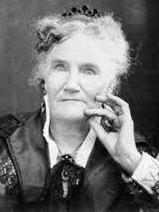 On December 10, Territorial Governor John Campbell signed into law a bill that gave women in Wyoming the right to vote. Was it a publicity stunt to attract women to an area where there were six men for every woman? Was it a joke? Was it a partisan political strategy gone bad? It pleased some and angered many; Judge J W Stillman resigned his post in protest. Enter Esther Hobart Morris, barely settled in her new home. After some prodding, she completed an application for the vacant post and submitted the required $500 bond. District Court Judge John Kingman appointed her as Justice of the Peace after the Sweetwater County Board of Commissioners approved her application in a vote of two to one. The County Clerk telegraphed a press release and word went out to the world on February 14, 1870:
On December 10, Territorial Governor John Campbell signed into law a bill that gave women in Wyoming the right to vote. Was it a publicity stunt to attract women to an area where there were six men for every woman? Was it a joke? Was it a partisan political strategy gone bad? It pleased some and angered many; Judge J W Stillman resigned his post in protest. Enter Esther Hobart Morris, barely settled in her new home. After some prodding, she completed an application for the vacant post and submitted the required $500 bond. District Court Judge John Kingman appointed her as Justice of the Peace after the Sweetwater County Board of Commissioners approved her application in a vote of two to one. The County Clerk telegraphed a press release and word went out to the world on February 14, 1870:
Wyoming, the youngest and one of the richest Territories in the United States, gave equal rights to women in actions as well as words.
On her first day in office, Esther wore “a calico gown, worsted breakfast shawl, green ribbons in her hair, and a green necktie,” and her first order of business was to arrest Stillman, who refused to hand over his court docket to her. Esther held court in the living room of her log cabin; when lawyers tried to embarrass her with legal technicalities, she was quick to let them know whose court they were in. One lawyer recalled “to pettifoggers she showed no mercy.” Her sons supported her; Archy was district clerk and Robert kept court records; but her husband John opposed her appointment; he reportedly made such a scene in her courtroom she had him jailed.
Her term expired December 6, 1870 and she sought re-election but failed to muster a nomination from the Republican or Democratic Party. The Wyoming Tribune in Cheyenne published the comments of Territorial Secretary Lee, “the people of Sweetwater County had not the good sense and judgment to nominate and elect her for the ensuing term.”
Despite little formal education, Esther handled her courtroom competently. She ruled on 26 cases while in office; none were reversed on appeal. Dr Phil Roberts, of the University of Wyoming, said “…(she) ably demonstrated she could carry out this important civic duty. It doesn’t seem very revolutionary now, but in the times, it was. She is symbolically very powerful.” Within a year of her term, Wyoming women sat on a jury for the first time. Wyoming’s gains prompted activist Susan B Anthony to call for Eastern women to migrate en masse to Wyoming.
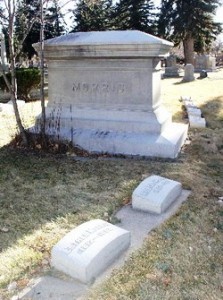 Esther’s involvement in women’s causes punctuated her life after she left South Pass City, and her husband; she lived in New York for a while, then Illinois, before returning to Wyoming in the 1880’s to be with her son in Cheyenne. She served as vice president of the National American Woman Suffrage Association and participated in the San Francisco convention in 1872; she addressed the convention in Philadelphia in 1876; she attended the Republican National Convention in St Louis as a delegate in 1896. Esther died April 2, 1902 and is buried in Cheyenne’s Lakeview Cemetery.
Esther’s involvement in women’s causes punctuated her life after she left South Pass City, and her husband; she lived in New York for a while, then Illinois, before returning to Wyoming in the 1880’s to be with her son in Cheyenne. She served as vice president of the National American Woman Suffrage Association and participated in the San Francisco convention in 1872; she addressed the convention in Philadelphia in 1876; she attended the Republican National Convention in St Louis as a delegate in 1896. Esther died April 2, 1902 and is buried in Cheyenne’s Lakeview Cemetery.
In 1960 Wyoming recognized her role in the suffrage movement by donating a life-sized bronze statue of her to the National Statuary Hall Collection in Washington, DC; in 1963, the replica was placed at the front of the Wyoming State Capitol, where I saw it today. Flowers lay across one arm, in her hand she holds a document – perhaps the docket of a Justice of the Peace?
Shoshone Chief Washakie (1804-1900)
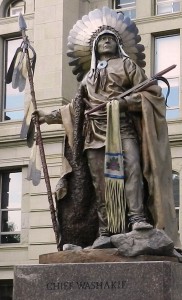 Was Chief Washakie born in 1798 or 1808? Stories vary; his gravemarker shows 1804. Stories vary as to his name and early days as well; one version is that when he was young his father was killed by an attack on their Salish tribe near the Three Forks (Montana) and he was lost and possibly wounded; and that he was adopted by the leader of a Shoshone band and lived with them for the next two and a half decades, learning the ways of the Shoshone warrior. One of his battle tactics was to place stones in an inflated dried balloon of buffalo hide and tie it to a stick; he used the device to frighten the horses of his enemies; hence the name “Rattler” or “Washakie.”
Was Chief Washakie born in 1798 or 1808? Stories vary; his gravemarker shows 1804. Stories vary as to his name and early days as well; one version is that when he was young his father was killed by an attack on their Salish tribe near the Three Forks (Montana) and he was lost and possibly wounded; and that he was adopted by the leader of a Shoshone band and lived with them for the next two and a half decades, learning the ways of the Shoshone warrior. One of his battle tactics was to place stones in an inflated dried balloon of buffalo hide and tie it to a stick; he used the device to frighten the horses of his enemies; hence the name “Rattler” or “Washakie.”
Washakie was chief of the Shoshone by 1850, about the time wagon trains began to rumble through Shoshone country. Shoshone land encompassed more than 44 million acres, stretching from the Salt Lake valley in Utah to the Tetons, and into what is today Yellowstone National Park. Washakie and his council had a decision to make – fight for their lives against the takeover, or make peace with their new neighbors? They attacked every stage station along the Oregon Trail in 1862, from what is now Casper to the Utah border.
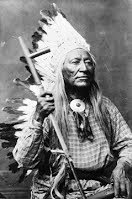 However, realizing that the expansion of white civilization into the West was inevitable, by the mid 1860’s the Shoshone began to ally with the whites. They assisted U S Army operations, gave advice to advancing military forces, fought against hostile Sioux and Cheyenne, and granted right-of-way to the Union Pacific Railroad. They also assisted wagon trains, helped weary travelers ford streams, and recovered stray cattle. Washakie negotiated with the Army and with the Shoshone to ensure the preservation of over three million acres in Wyoming’s Wind River country. On July 3, 1868, he signed the Fort Bridger Treaty along with seven United States military men.
However, realizing that the expansion of white civilization into the West was inevitable, by the mid 1860’s the Shoshone began to ally with the whites. They assisted U S Army operations, gave advice to advancing military forces, fought against hostile Sioux and Cheyenne, and granted right-of-way to the Union Pacific Railroad. They also assisted wagon trains, helped weary travelers ford streams, and recovered stray cattle. Washakie negotiated with the Army and with the Shoshone to ensure the preservation of over three million acres in Wyoming’s Wind River country. On July 3, 1868, he signed the Fort Bridger Treaty along with seven United States military men.
Many of the government’s promises in the Fort Bridger Treaty fell through though, and Washakie spoke out: “Oh sir, I hesitate, for I cannot tell the half! It does not protect our rights…I say again, the government does not keep its word!” Shoshone land dwindled; today the Wind River Indian Reservation spans just two million acres. Washakie saw his tribe suffer greatly, experiencing high mortality rates from starvation. The buffalo were gone, and the chief had little bargaining power left.
Yet he is remembered today for his prowess in battle, his efforts for peace, and his commitment to his people’s welfare. During the settlement of the West, he was front and center in the “unsettling” of the Native American way of life, the toughest battle he ever fought. Washakie learned French and English from trappers and traders, and he spoke a number of Native American languages. He counted as friends pioneer Brigham Young, and frontiersmen Kit Carson, John Fremont, and Jim Bridger; Bridger became “family” when he married one of Washakie’s daughters. Washakie was determined that Native Americans be educated, and he gave land to Welsh clergyman John Roberts to establish a boarding school  where Shoshone girls learned traditional crafts and language. Washakie became a member of the Mormon church in 1880; in 1897 he was re-baptized as an Episcopalian. He died February 20, 1900, and is buried in the Fort Washakie Cemetery on the Wind River Reservation.
where Shoshone girls learned traditional crafts and language. Washakie became a member of the Mormon church in 1880; in 1897 he was re-baptized as an Episcopalian. He died February 20, 1900, and is buried in the Fort Washakie Cemetery on the Wind River Reservation.
Fort Washakie was renamed for him in 1878, the only US military outpost to be named after a Native American. Washakie County, Wyoming is named for him; so is the dining hall at the University of Wyoming. During WWII a Liberty Ship was named the SS Chief Washakie; A U S Navy harbor tug was named the USS Washakie in 1944. His statue stands in downtown Casper, Wyoming; and on September 7, 2000 his statue was placed in the National Statuary Hall Collection in Washington, DC. A replica was also placed at the front of the Wyoming State Capitol, where I saw it today. He wears the full regalia of a chief, and holds the pipe that stands for peace.
About the Wind River Reservation and Chief Washakie’s grave http://www.windriver.org/info/drivingtours/windriverindianreservation.php
